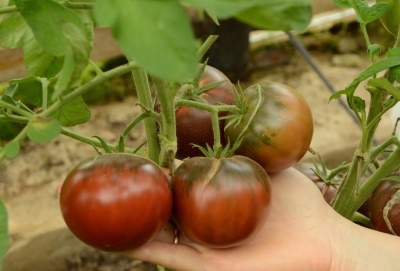
- Appeared when crossing: pink-fruited Mikado x unknown tomato
- Name synonyms: Mikado Black, Mikado Chernyi
- Category: grade
- Growth type: indeterminate
- Appointment: fresh consumption, for juice, for ketchup and tomato paste
- Ripening period: early
- Ripening time, days: 100-105
- Growing conditions: for open ground, for closed ground, for greenhouses
- Bush size: tall
- Bush height, cm: up to 200
Every year, with the onset of spring, summer residents start gardening chores. An important step is the selection of suitable vegetable varieties that can withstand the vagaries of the weather and diseases. Special attention should be paid to the black Mikado tomato, which has been popular among consumers for quite a long time, since it has an unusual color and delicious taste.
Description of the variety
The plant is of an indeterminate type, standard, tall, reaching a height of 200 cm. Despite the fact that the bushes are quite strong and compact, they must be tied up and formed into several stems. The shoots are strong and thick. The leaves resemble more potato leaves, they are huge, wide, whole or semi-whole, dark green in color.
The main qualities of the fruit
The fruits of the variety are large, the mass of one reaches 250-320 g. Their shape is flat-round, there may be small ribs near the stalk. The color of ripe tomatoes is unusual - from burgundy-pink to burgundy-brown, near the stalk the color is brown-green. The pulp is dense and juicy, dark red in color.
Taste characteristics
Mikado black is considered an excellent salad tomato. The fruit has a sweet taste with a pleasant sourness, with an unusual fruity aftertaste. The pulp of ripe tomatoes is very aromatic, tender, sugary, fleshy and juicy. The culinary destination is extensive. Best used fresh, but can be processed into juice, tomato paste, or ketchup.
Ripening and fruiting
It is considered an early variety. From the first shoots to technical ripeness, 100-105 days pass. The harvest period is extended from July to September.
Yield
The yield indicators for the variety are average. With proper care, 14-17 kg of fruit are obtained from one square meter. On one brush, 5-7 pieces of tomatoes are formed. The harvested crop lays poorly (2-5 days), therefore, Mikado black is not grown on an industrial scale, since the tomato loses its presentation during transportation.
The timing of planting seedlings and planting in the ground
Seeds begin to germinate 90 days before planting in the soil. The optimal time for this event is late February - early March. For cold regions, it is permissible to start sowing in early April.
If you are not sure that the manufacturer has not previously prepared the seeds or they were purchased from hands, then before proceeding with sowing, the planting material should be disinfected and treated with a preparation to stimulate growth.
Further, holes 1.5 cm deep are made in the nutrient soil, the seeds are deepened and carefully covered with earth, slightly compacted. For growing seedlings, you can use separate peat cups, containers or a greenhouse.
In order for the seeds to sprout together, a certain temperature regime is required - + 23-25 degrees. Watering is moderate, but not plentiful. After the emergence of seedlings, they should be left in the fresh air every day, first for 5-10 minutes, increasing the time to several hours.
After the appearance of full-fledged 2-3 leaves on the seedlings, they dive. The seedlings begin to be transferred to a permanent place in mid-May - early June, as soon as the flower tassel begins to form.

Growing tomato seedlings is an extremely important process, because it largely depends on whether the gardener can harvest at all. All aspects must be taken into account, from seedbed preparation to planting in the ground.
Landing scheme
Due to the fact that the plant is large, the distance between the bushes is 60 x 50 cm. No more than 4 pieces are placed on one square meter. So the plants will not interfere with each other during growth, the main thing is to avoid excessive thickening. For this, the formation is carried out.

Growing and caring
Black Mikado tomato prefers fertile, slightly acidic and loamy soils. The best predecessors for it are onions and carrots. It is categorically impossible to plant a crop after potatoes, cabbage, peppers and eggplants. Since they have common pathogens and pests.
You need to start planting in the evening or in cloudy weather. A shallow hole is made, where the seedling is neatly placed, the roots are sprinkled with earth, tamped and watered abundantly. To facilitate the adaptation period for the culture and speed up the rooting process, the seedlings can be covered with foil for several weeks.
During the adaptation time, seedlings require moderate watering as the soil dries out. After irrigation, abundant irrigation is necessary, at least 3 times a week. For less moisture loss, mulching is used. Mikado black for good development requires additional nutrition in the form of mineral and organic fertilizers, which are applied once every 2 weeks.
A tall plant needs a mandatory garter to the support, the trellis option is best. If you ignore this procedure, the stems will begin to creep along the ground, and this can lead to fruit rot.




A plant needs different micronutrients at each stage of growth. All fertilizers can be divided into two groups: mineral and organic. Folk remedies are often used: iodine, yeast, bird droppings, eggshells.
It is important to observe the rate and period of feeding. This also applies to folk remedies and organic fertilizers.
Disease and pest resistance
The variety has good resistance to most infectious diseases and pests. However, the plant has low resistance to brown spotting and is often attacked by whitefly. To combat them, special preparations are used with which the tomato is treated before flowering.



























































































